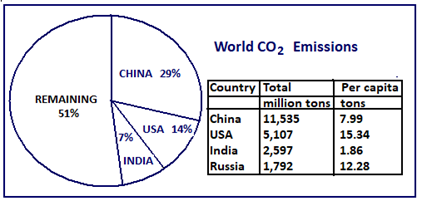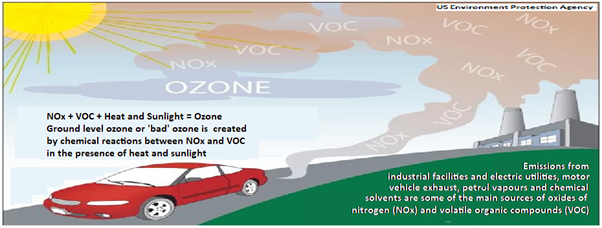Carbon emission hurts the world, a high ozone level hurts just us, says S.Ananthanarayanan.
.bmp">India has the distinction of being the 3rd largest emitter of CO2 in the world. That India has the 2nd largest population may mitigate the shame, but not the price India would pay for CO2 linked global warming. And still, some may find consolation because the evils would be shared by all countries of the world.

There is, however, another distinction where India pays a heavy price, and the cost is borne by India alone. This is in the emissions that result in high ozone levels, which cause respiratory disease and serious diminution of forest and agricultural produce. And global warming is expected to worsen the effect.
On the harm that ozone does , the journal, Nature Food carries a report by Zhaozhong Feng, Yansen Xu, Kazuhiko Kobayashi, Lulu Dai, Tianyi Zhang, Evgenios Agathokleous, Vicent Calatayud, Elena Paoletti, Arideep Mukherjee, Madhoolika Agrawal , Rokjin J. Park, Yujin J. Oak and Xu Yue, from Nanjing University of Information Science & Technology, Nanjing, China, Ministry of Agriculture and Rural Affairs, and Chinese Academy of Sciences, Beijing, the University of Tokyo, Seoul National University, National Research Council, Sesto Fiorentino, Italy, and Banaras Hindu University . The report collects data in a manner that has not been done so far and finds the reduction of yields of wheat, rice and maize crops, due to high ozone levels can be as high as 33%, 23% and 9%.
Ozone is a form of oxygen, but a more reactive form. While oxygen consists of molecules that contain two atoms, the ozone molecule has three atoms of oxygen. And ozone is formed when oxygen molecules split into a pair of independent oxygen atoms. The oxygen atoms thus set free can now combine with oxygen molecules to form ozone, like this:
O2 + O -> O3.
Ozone, however, is unstable and readily gives up its extra oxygen atom, which makes it more reactive, While being reactive has its uses, the downside is that even traces of ozone cause damage to plant tissue, or mucous or respiratory tissues of animals and humans.
The bulk, 90% of the ozone, fortunately, is found very high up in the atmosphere. As air is rarefied at high altitudes, the concentration of ozone is higher, at 2 to 8 parts per million. And high-altitude ozone performs a useful function of blocking harmful UV rays. Only the remaining, 10% of ozone, is there in the lower, or ground level atmosphere, and, till recent times, this presence was just 10 to 15 parts per billion.
But, with the start of the industrial period, the paper says, the levels have been increasing, world-wide, with levels in East Asia rising as high as 60 parts per billion. There has been slowing, even a decrease in USA and Europe in the last two decades, but the increase in Asia “has outweighed trends in other regions,” the paper says.
While rising O3 levels is a health hazard, another consequence is that it can bring down crop production - a threat to food security. The paper cites a published study which says that a level of 30-50 parts per billion (which was the average during 2010-12) leads to a fall in yield of 12.4%, 7.1%, 4.4% and 6.1% for soybean, wheat, rice and maize, respectively. And this adds up to 227 million tonnes, in a year.
High losses in the Asia region are disconcerting, as the paper notes that “Asia produces large portions of the world cereals: on average, 90% of rice, 32% of maize and 44% of wheat came from the region between 2014 and 2018.” Methods to estimate O3 related crop losses in Asia, however, have not been suited to the crops and conditions, the paper says. The authors have hence carried out specifically designed studies, covering Japan, South Korea and China, along with some parts of India.
The source of ground level ozone is not direct emission of ozone into the atmosphere. Ozone arises by reaction of other emissions, oxides of nitrogen, and different ‘volatile organic compounds.’ The main sources of the former, known as NOx, are burning of nitrogen compounds in motor fuel and the combination of oxygen and nitrogen in the air, at high temperature, as in IC engines and coal-based power plants. The use of fertilisers in agriculture is another major source. The main sources of the second factor, the human-made VOCs, are industrial chemicals, paints and solvents, even handling petroleum-based fuels, and combustion of fossil fuel, biofuel and biomass.

We can see that the rise in population and industrial activity, increased travel and means of transport are causes of rise in ground level ozone levels. The authors of the paper used ground-based ozone measurements at over 3,000 monitoring sites, in conjunction with existing and current experimental data of crop yields, to assess the crop losses that can be pinned on ozone levels. And there was another assessment, which could be regarded as a ‘control’, with the application of a compound, ethylenediurea (EDU), an ‘anti-ozonant,’ which counteracts the effect of ozone and enhances the yield of plants and crops that are limited by ozone.
The results of the trials were a measure called Relative Yield, or the ratio of the yield of farming under a level of ozone exposure, to the yield at a base level of exposure. And from this result, we can work out the Relative Yield Loss. At a base level of 40 parts per billion, it was found that wheat is the most sensitive, with loss of 38%, with rice the loss was 19%, maize lost 10%, and hybrid, high-yielding rice was hit by 42%. These rates of loss were confirmed by corresponding rise of production when the ozone suppressing, EDU was applied. And these yield losses of rice and wheat, as found in experiments in Asia, are significantly greater than those derived from experiments in North America and Europe, the paper says.
While Japan, South Korea and China are large producers of food grain, India is a large producer too. Although the paper does not examine the case of India, there are Indian studies which document high ground level ozone presence. Which means Indian crops are also suffering yield losses at the scale as reported in the paper.
A factor that makes things worse is that ozone production rises with temperature. The reaction of NOX with VOCs, which give rise to ozone, is faster in the daytime and during the summer months. The rise of temperature in a warming world would hence heavily dent the crop yield in regions with high ground level ozone. As India is one such, she needs urgently to contain the ozone levels that she faces.
One urgent measure would be to promote the use of public transport. The wisdom of moving to the electric vehicle is still not clear, as our electricity generation depends heavily on coal, and our coal is low-grade. With the danger presented by ozone, and rising demand for food, India needs to rethink priorities.
------------------------------------------------------------------------------------------ Do respond to : response@simplescience.in-------------------------------------------